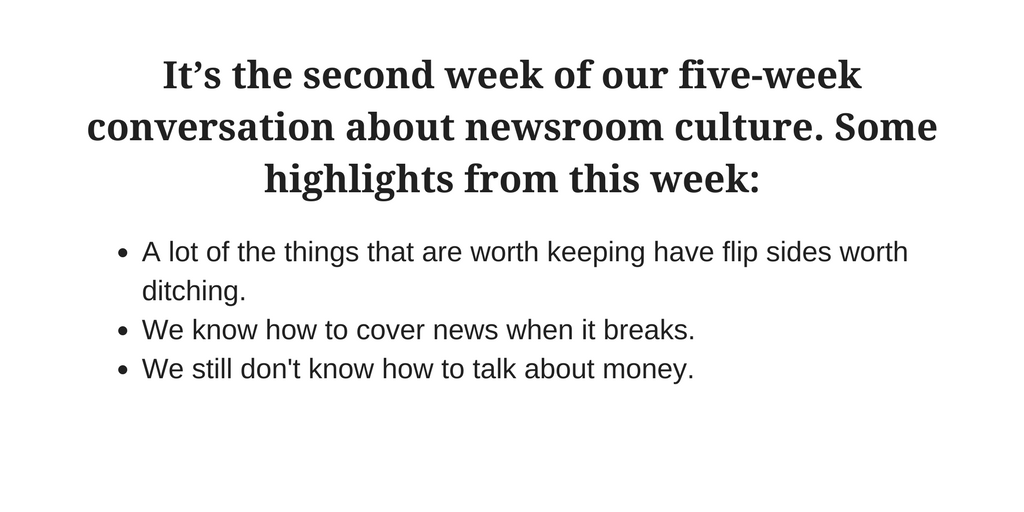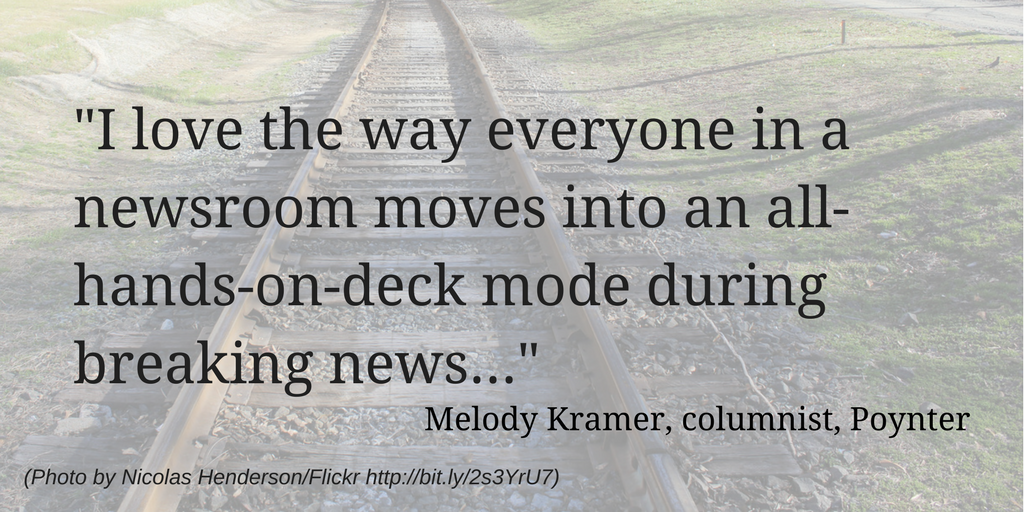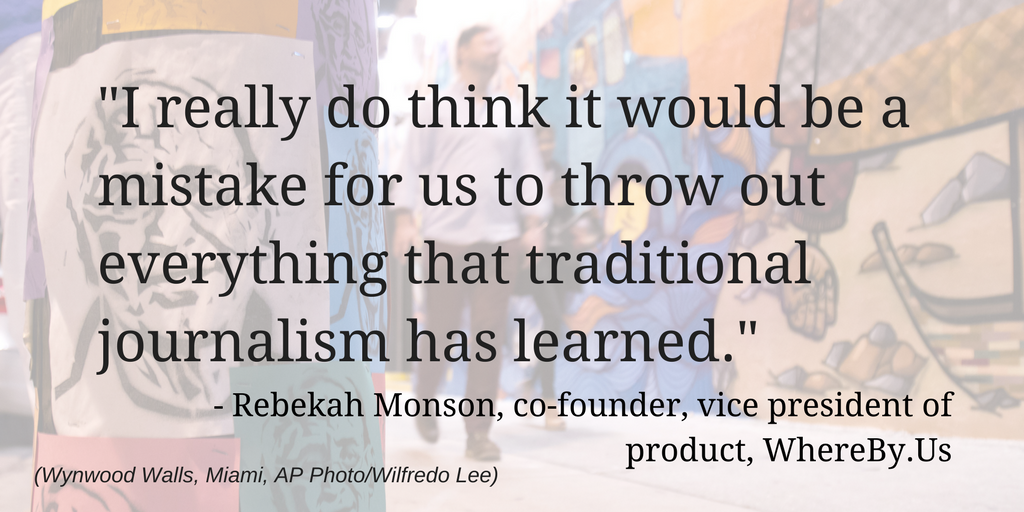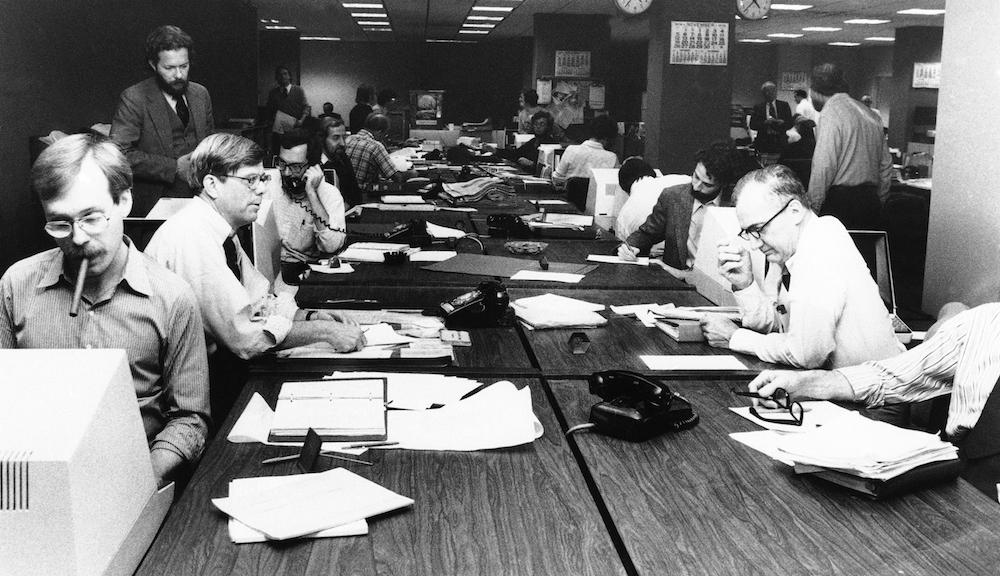This piece originally appeared in Local Edition, our newsletter following the digital transformation of local news. Want to be part of the conversation? You can sign up here.

Last week, I saw a lot of news that made me shout out “that’s newsroom culture!” (My family already thinks I’m pretty strange, so they didn’t react much.)
Here’s a quick recap:
– A U.S. newsroom sent pizza to a U.K. newsroom as it covered another tough story.
– Journalists quickly defended a reporter assaulted in Montana by a person running for office.
– There was a tribute to the people and process that produced the news for generations in Boston.
– There was a whole celebration of the news and its place in the community in Minneapolis.
– And we saw a call to work together and cover hushed-up newsroom layoffs happening around the country.
That, to me, is part of our journalism/newsroom culture. The good part.
But we’re talking about culture here because we have to, not because it’s fun. How newsrooms adapt, how they communicate, how they work is part of how they will or will not get to whatever things are coming next for local journalism.
Last week, I asked people to share the things they love and the things they’d love to change about newsroom culture. I heard back from some of you and reached out to smart journalists around the country for their perspectives, too. Here’s what they said:

We do know how to rally.
“I love the way everyone in a newsroom moves into an all-hands-on-deck mode during breaking news, and I love the way the people I’ve worked with in news are curious about the world, love learning, and love figuring out the best ways to share what they’ve learned with others,” said Melody Kramer, a Poynter columnist.
“We certainly take a lot of lessons from how newsrooms operate,” said Rebekah Monson, co-founder and vice president of product of WhereBy.Us, the company behind Miami’s The New Tropic and Seattle’s The Evergrey. “Newsrooms are super great at quickly being able to react to news. That’s what they’re built to do.”
“Rigor,” said Amanda Zamora, chief audience officer at The Texas Tribune. “In all the newsrooms I’ve worked in, I think one of the common threads of culture has been rigor. Whether you’re in live news, on social, working in data or investigative or multimedia, we tend to make sure we have systems in place for producing the most credible and compelling journalism we can. The systems vary, but we have them and we adapt them, and I think this is one of the marvels of what we do, producing that much original journalism on deadline every day.”
But we’re stuck, sometimes literally, in our chairs:
“I’ve worked at organizations where everyone is remote, and we had the same ‘all-hands-on-deck’ mentality working through chat and video,” Kramer said. “Which brings me to what I dislike about most newsroom culture: the idea that you have to be at a desk in a certain city during certain hours. This makes no sense to me.
“I’ve written about this before — the idea that newsrooms should spread their mastheads across the country to prevent groupthink. But there’s also the idea that people have stuff going on outside of work, and flexibility allows more different types of people to work for a newsroom, and to produce consistently good work. And there’s also the fact that cities are really, really expensive places to live — so only certain types of people can afford to live in them. That’s likely preventing the diversity of story ideas we champion so much at conferences.”
“We work from everywhere. Last week I was in L.A. and Vegas. I could never do that in a traditional newsroom,” Monson said. “We trust you to get your work done. We don’t care where you do it.”
A lot of us are driven by a shared set of values:
“Maybe it’s more pronounced because of the nonprofit, mission-based journalism we do at the center, but having a set of ideals to guide our work creates a sense of community and togetherness that I think is vital to a newsroom,” said Mia Sato, an intern at the Wisconsin Center for Investigative Journalism.
“As a young journalist at the beginning of my career, it’s been really helpful to be welcomed into a newsroom that instills a sense of purpose in me – it has helped me understand why I was drawn to this field, why I’ve stayed with it and why (at this point in my life) I can’t see myself doing anything else,” Sato said. “Our guiding principles are to protect the vulnerable, expose wrongdoing and to seek solutions, and having that ideal to look up to, especially so early in my career, has shaped me, I think, at the most opportune time. It’s harder to break a habit or belief the longer you’ve held it.”
But we can get stuck in them without examining them, too:
“Sometimes we get caught in molds of what we think journalism needs to look like, how we have to interact with audiences, and what it means to be a good journalist,” Sato said. “I think it would be helpful to remind ourselves how many changes, different iterations and external pressures journalism has gone through, and begin to think outside the box and prepare for the inevitable shifts in the field and greater society.”
We can be pretty good at working together:
“I love how well our departments collaborate, so editorial, advertising, marketing and product stay on the same page with the same goals,” said Dana Sitar, a senior writer at The Penny Hoarder.
“I like that most of the people in the newsroom are students at MU; we’re collaborative workers and are learning the ropes together,” said McKenna Blair, a student reporter at the Missouri School of Journalism.
“…It’s great to see the new collaborative journalism environment emerge, in which different news organizations are working together to produce the best work they possibly can, rather than fighting one another,” said Connor Sheets, an investigative reporter at Alabama Media Group. “That’s something that would have been almost unimaginable a decade or two ago, and it can only be a good thing for journalism and society as a whole.”
But newsrooms can still be a tough place if you’re not white and a man:
“There have been too many times where I’ve been the only non-white journalist in a class, at an event, in a room,” Sato said. “I recently heard the need for diversity expressed really eloquently: the world outside our newsroom is diverse, so the people reporting on it also need to be; otherwise, we aren’t being accurate. Diversity of thought, experience, economic background, religion, gender, country of origin, everything is important. We need to do better to represent the communities we serve and seek to inform.”
We seem to be getting back to why most of us got into this in the first place:
“I think that over the past few years, journalism culture has made a significant move away from the frenzied clickbait, must-get-traffic-at-all-costs obsession, and in fact begun to realize that there is huge value — and clicks! — in (re)developing a trusted news brand and delivering scoops, impactful investigations and meaningful content to local communities, as well as to the national audience,” Sheets said. “It seems that more newsroom dollars and jobs are being dedicated to investigative reporting each year, and there is a vitality in that segment of the industry that seems to be continuing to grow. That’s a great thing, and it helps make up for the loss of tens thousands of journalist positions we’ve lost since the turn of the century.”
But we may be in the ‘ooooh, shiny’ place still:
“I do feel that in many newsrooms there is currently too heavy an emphasis on buzzy ‘cutting-edge’ tools and pursuits like flashy new video technologies and eccentric engagement efforts,” Sheets said. “I think it’s key that editors realize that though these tools will have an important place in the news ecosystem of the future, it’s essential that we don’t put too many eggs in any one basket, mimicking the missteps and over-investment that all too often seem to define these types of developments.”
As an industry, we’ve figured out how to do a lot of things well:
“I really do think it would be a mistake for us to throw out everything that traditional journalism has learned,” Monson said. “We’re trying to iterate on things we already know.”
But talking about money still makes a lot of us queasy:
“If you’re not thinking about money, then someone else is, and they’re enforcing that on you … I think it’s kind of a dangerous thing,” Monson said. “The things that you make serves the business goals of the company. How can you make them in a way that’s both true to your mission and your business? If you’re not actively thinking about that, there’s someone who’s maybe thinking less about the mission thinking about it for you.”
And we still make assumptions about our audience, if we’re thinking of them at all:
“We still put our own preferences and assumptions above the needs of our readers every single day. (Yes, even as we are doing kick-ass journalism. The two aren’t mutually exclusive,)” Zamora said. “At a time when we have more information than ever about our audiences, we’re still producing journalism with processes optimized around our own needs and ideas, as opposed to those of our audience. I think newsrooms need to reset the role of audience in the newsroom to amount to more than a leaderboard of stories. Reporters, editors, producers — pretty much everyone in the newsroom should have a sense of ownership of that audience relationship, with respect to their roles.”

Thanks, everyone, for talking newsroom culture with me. Next week, we’ll hear how Audrey Cooper, editor in chief of The San Francisco Chronicle, has tackled culture in that newsroom.
In the meantime, early registration for IRE’s annual conference ends June 2. You can sign up now for LION’s annual conference in Chicago in October. And Poynter’s News University has a Webinar on June 6 that will help you pick images on deadline.
Have a fantastic four-day week!
Correction: An earlier version of this story said Mia Sato is a journalism student at the University of Wisconsin, Madison. She actually just graduated. It has been corrected. We apologize for the error. And congrats, Mia!







